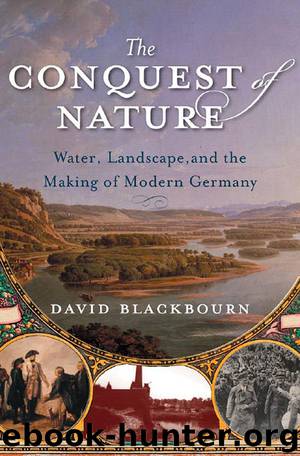The Conquest of Nature by David Blackbourn

Author:David Blackbourn
Language: eng
Format: epub
Publisher: W. W. Norton & Company
Published: 2016-04-07T04:00:00+00:00
German “resettlers” in occupied Poland, 1941.
Five
______________
RACE AND RECLAMATION
National Socialism in Germany and Europe
A Gray-Dark Wilderness
IN THE 1930S THE PRIPET MARSHES STRADDLED the border between Poland and the Soviet Union. They covered some 100,000 square miles and formed (as they still do) the largest wetlands in Europe. The region was dominated by marshes, moors, and lakes that were on their way to becoming moors, a landscape of willows and reeds interspersed with sandy dunes and forested belts of pine, birch, and alder that gave the area its Polish name Polessia, or “woodlands.” Tributaries of the River Pripet like the Stochod, the “river of a hundred ways,” drained down from the surrounding heights into a shallow basin. These meandering streams gave the whole area its character. In March and April ice-jams and waters swollen by snowmelt caused their shallow banks to overflow, flooding the land all around. The result was a waterworld much like the Oderbruch before it was drained, but on a vastly larger scale. Wolves and wild boar lived in the wooded areas, wild ducks and wild geese filled the sky, mosquitoes enjoyed a perfect breeding ground. A few wood-fired steamships traveled up and down the larger rivers like the Pripet and Horyn from their base in Pinsk, carrying passengers or towing giant rafts, but navigating the smaller channels was possible only with a flat-bottomed boat. Travel in many parts of the Pripet Marshes had to await the onset of winter, which froze the shallow lakes and waterways.1
Some visitors in the 1930s were entranced by what they saw. One was the American geographer Louise Boyd, who made a trip there while attending the International Congress of Geographers at Warsaw in 1934 and wrote an account strongly tinged with romantic attraction to the “wild solitude” of the marshes. She was impressed by the “great silence—a silence broken only by the occasional swish of canoe paddles or the rare whistle of a steamer,” and interested enough in the people who lived there to write admiringly about their resourcefulness and local knowledge.2 Martin Bürgener, a German geographer from Danzig, was made of sterner stuff. His book on the Pripet Marshes came out in 1939. Bürgener was not entirely immune to the beauty of a region where he had traveled extensively in the mid-1930s. But when he described it as “one of the least developed and most primeval areas of Europe,” this was not intended as a compliment.3 What Bürgener saw in this “gray-dark wilderness” was a series of problems: anarchic waterways, insects and vermin that were uncontrolled, an unstable economy based on hunting, fishing, or primitive agriculture, and a population “vegetating in hopeless apathy.”4 This, after all, was the Urheimat, or original home, of the Slavs—or so, at least, the German Slavicist Max Vasmer had proved to the satisfaction of many German scholars of the time, Bürgener among them.5 That the Slav race supposedly hailed from this “wilderness” was no trivial claim in the politically charged scholarly debates of the interwar years, for
Download
This site does not store any files on its server. We only index and link to content provided by other sites. Please contact the content providers to delete copyright contents if any and email us, we'll remove relevant links or contents immediately.
| Africa | Americas |
| Arctic & Antarctica | Asia |
| Australia & Oceania | Europe |
| Middle East | Russia |
| United States | World |
| Ancient Civilizations | Military |
| Historical Study & Educational Resources |
Room 212 by Kate Stewart(4737)
The Crown by Robert Lacey(4572)
Endurance: Shackleton's Incredible Voyage by Alfred Lansing(4505)
The Iron Duke by The Iron Duke(4122)
The Rape of Nanking by Iris Chang(4022)
Killing England by Bill O'Reilly(3897)
Joan of Arc by Mary Gordon(3782)
Say Nothing by Patrick Radden Keefe(3725)
I'll Give You the Sun by Jandy Nelson(3272)
Shadow of Night by Deborah Harkness(3174)
Hitler's Monsters by Eric Kurlander(3164)
Mary, Queen of Scots, and the Murder of Lord Darnley by Alison Weir(3064)
Blood and Sand by Alex Von Tunzelmann(3055)
Darkest Hour by Anthony McCarten(3018)
Margaret Thatcher: The Autobiography by Thatcher Margaret(2971)
Eleanor & Park by Rainbow Rowell(2943)
Red Famine: Stalin's War on Ukraine by Anne Applebaum(2816)
Book of Life by Deborah Harkness(2718)
The One Memory of Flora Banks by Emily Barr(2684)
